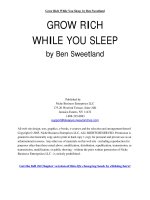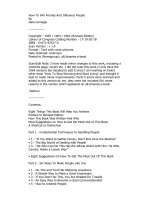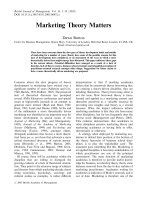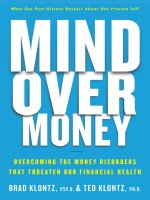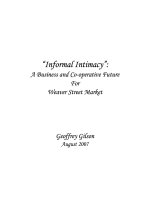Notes on Influencer by Kerry Patterson_1 doc
Bạn đang xem bản rút gọn của tài liệu. Xem và tải ngay bản đầy đủ của tài liệu tại đây (830.12 KB, 21 trang )
Influencer
The
Power
To Change
Anything
Kerry Patterson • Joseph Grenny
David Maxfield • Ron McMillan • Al Switzler
McGraw-Hill
New York Chicago San Francisco
Lisbon London Madrid Mexico City
Milan New Delhi San Juan Seoul
Singapore Sydney Toronto
Copyright © 2008 by VitalSmarts, LLC. All rights reserved. Manufactured in the United States
of America. Except as permitted under the United States Copyright Act of 1976, no part of this
publication may be reproduced or distributed in any form or by any means, or stored in a
database or retrieval system, without the prior written permission of the publisher.
0-07-159245-9
The material in this eBook also appears in the print version of this title: 0-07-148499-X.
All trademarks are trademarks of their respective owners. Rather than put a trademark symbol
after every occurrence of a trademarked name, we use names in an editorial fashion only, and
to the benefit of the trademark owner, with no intention of infringement of the trademark.
Where such designations appear in this book, they have been printed with initial caps.
McGraw-Hill eBooks are available at special quantity discounts to use as premiums and sales
promotions, or for use incorporate training programs. For more information, please contact
George Hoare, Special Sales, at or (212) 904-4069.
TERMS OF USE
This is a copyrighted work and The McGraw-Hill Companies, Inc. (“McGraw-Hill”) and its
licensors reserve all rights in and to the work. Use of this work is subject to these terms. Except
as permitted under the Copyright Act of 1976 and the right to store and retrieve one copy of
the work, you may not decompile, disassemble, reverse engineer, reproduce, modify, create
derivative works based upon, transmit, distribute, disseminate, sell, publish or sublicense the
work or any part of it without McGraw-Hill’s prior consent. You may use the work for your
own noncommercial and personal use; any other use of the work is strictly prohibited. Your
right to use the work may be terminated if you fail to comply with these terms.
THE WORK IS PROVIDED “AS IS.” McGRAW-HILL AND ITS LICENSORS MAKE NO
GUARANTEES OR WARRANTIES AS TO THE ACCURACY, ADEQUACY OR COM-
PLETENESS OF OR RESULTS TO BE OBTAINED FROM USING THE WORK,
INCLUDING ANY INFORMATION THAT CAN BE ACCESSED THROUGH THE WORK
VIA HYPERLINK OR OTHERWISE, AND EXPRESSLY DISCLAIM ANY WARRANTY,
EXPRESS OR IMPLIED, INCLUDING BUT NOT LIMITED TO IMPLIED WARRANTIES
OF MERCHANTABILITY OR FITNESS FOR A PARTICULAR PURPOSE. McGraw-Hill
and its licensors do not warrant or guarantee that the functions contained in the work will meet
your requirements or that its operation will be uninterrupted or error free. Neither
McGraw-Hill nor its licensors shall be liable to you or anyone else for any inaccuracy, error or
omission, regardless of cause, in the work or for any damages resulting therefrom.
McGraw-Hill has no responsibility for the content of any information accessed through the
work. Under no circumstances shall McGraw-Hill and/or its licensors be liable for any
indirect, incidental, special, punitive, consequential or similar damages that result from the use
of or inability to use the work, even if any of them has been advised of the possibility of such
damages. This limitation of liability shall apply to any claim or cause whatsoever whether such
claim or cause arises in contract, tort or otherwise.
DOI: 10.1036/007148499X
We dedicate this book to influencers everywhere—
to the tenacious scholars and practitioners who, through the
careful blending of theory and experience, have not only
added to an ever-growing knowledge of how things work, but
have also curbed the cynic’s smirk, restored hope, and made it
possible for each of us to become a powerful agent of change.
This page intentionally left blank
Contents
Authors’ Note ix
PART 1: The Power to Change Anything 1
Choose influence over serenity.
1 You’re an Influencer 13
A small group of remarkable leaders and scholars has
been quietly changing the world by influencing people’s
behavior.
2 Find Vital Behaviors 23
Big problems succumb to changes in just a
few behaviors.
3 Change the Way You Change Minds 45
Changing behavior requires changing minds.
PART 2: Make Change Inevitable 73
The six sources of influence
4 Make the Undesirable Desirable 83
Personal Motivation
Overcome reluctance and resistance
by connecting to values.
5 Surpass Your Limits 111
Personal Ability
New behavior requires new skills. Overinvest
in learning how to master skills and emotions.
For more information about this title, click here
vi
6 Harness Peer Pressure 137
Social Motivation
Enlist leaders, partner with opinion leaders,
and become an opinion leader yourself.
7 Find Strength in Numbers 167
Social Ability
Amplify influence through just-in-time teamwork.
8 Design Rewards and Demand Accountability 193
Structural Motivation
Modestly and intelligently reward early successes.
Punish only when necessary.
9 Change the Environment 219
Structural Ability
Harness the pervasive and invisible power
of environment to support new behavior.
10 Become an Influencer 253
Overdetermine success by implementing multiple
sources of influence.
Additional Tools and Resources 273
Works Cited 275
Acknowledgments 287
Index 288
About the Authors 299
Influencer
The
Power
To Change
Anything
This page intentionally left blank
ix
Authors’ Note
F
or more than two decades we’ve felt an obligation to
write this book. But the thought of capturing the strate-
gies of influence masters worldwide was a daunting task,
so we did what many authors have done under similar circum-
stances. We put off writing as long as we could.
Then three experiences convinced us that we had to write
the book. The first took place in 1997 when we were practi-
cally knocked over by the results of an influence project we’d
been working on for the previous 18 months at the Fort Worth
Tactical Aircraft Division of Lockheed Martin—home of the
F-16 fighter jet. Not only had the intervention been success-
ful, but it had been remarkably successful. We had assisted lead-
ers in attempts to influence a handful of key behaviors and, sure
enough, the behaviors had improved substantially. More
importantly, so had key outcomes ranging from productivity,
to costs, to quality, and employee satisfaction.
With the completion of this successful change project, we
had now demonstrated on over two dozen separate projects that
when leaders apply sound influence theory to vexing organi-
zational problems, they can dramatically improve results. By
1997 over a quarter of a million employees from these two
dozen companies had been touched in ways that improved not
only their organizations, but also their personal lives.
We received a second nudge to write a book about influ-
ence when we initiated a study to uncover every intervention
we could find that had successfully influenced behavior change
Copyright © 2008 by VitalSmarts, LLC. Click here for terms of use.
X Authors’ Note
in organizations. As we pored over the rather massive body of
literature, we learned there were embarrassingly few examples
of leaders who had been successful at influencing employees
to act in new ways. Most of the influence books and articles
we found sounded as if they had been penned by prophets of
doom rather than professors of change.
But this didn’t make any sense. It wasn’t as if behavior
change was a new topic. For more than five decades social sci-
entists and skilled practitioners had amassed an impressive lit-
erature that demonstrated that influence efforts, when based on
sound theory and implemented by a knowing practitioner, had
routinely led to lasting improvements. Perhaps it was time we
located these individuals and shared their methods.
When we eventually tracked down the best of the seasoned
influencers, we received our third and final nudge to write this
book. Their work was simply too intriguing not to share. The
journey to find them took us far beyond our corporate roots to
points scattered all over the world, but the trip was well worth
it. From Bangkok to Boston, we found quiet but tenacious influ-
encers who had solved world-sized problems in world-class
ways—solely by influencing how people behave.
We were ultimately compelled to write this book when it
became clear that the influence strategies every one of these
impressive change agents employed were based on the same
set of theories and principles we had been applying in organi-
zations for over 20 years. These are ideas we learned at the feet
of renowned scholars and that we now introduce as a unified
theory of influence.
We apologize for our procrastination. At long last, meet the
influencers.
Part
1
Copyright © 2008 by VitalSmarts, LLC. Click here for terms of use.
This page intentionally left blank
3
The Power to
Change Anything
I
f you’re like most people, you face several influence chal-
lenges that have you stumped. For instance, at work you’re
fighting an uphill battle. You’ve given your heart and soul
to a quality-improvement program, but your best efforts to make
quality part of the everyday culture have yielded no improve-
ments whatsoever. None.
At the personal level, you’re fighting a weight problem that
has gone on for years. Actually you have a metabolism problem.
It turns out your body doesn’t burn 6,000 calories a day. Talk
about bad luck.
At the family level, your oldest son just turned 13, and he
hangs out with a pretty frightening-looking crowd that appears
to have lost all interest in civility, decency, and hair care. You’ve
tried reasoning and bribing and even a well-timed threat, but
when you talk to him, there’s no one home. It’s as if the day
he turned 13 your ability to influence him expired.
At the community level, you have a neighbor who allows
three vicious, three-foot-tall pit bulls to wander his backyard
with impunity. The problem is his four-foot fence. It’s just a
matter of time until the dogs break out and run wild, but the
local animal control people won’t do a thing about it. Accord-
ing to them, someone has to suffer before they can take action.
To cap the whole thing off, your region of the country is going
through a five-year drought because apparently the world is
heating up like a meatball in a microwave.
And you can’t fix any of this.
Copyright © 2008 by VitalSmarts, LLC. Click here for terms of use.
4 INFLUENCER
Fortunately you’ve learned to follow the words of a well-
known prayer: Every day you ask for the serenity to accept the
things you cannot change, the courage to change the things you
can, and the wisdom to know the difference. Somehow that gets
you through.
THE SERENITY TRAP
And that’s the problem. It’s everyone’s problem. We’ve come
to believe that when we face enormous challenges that can be
solved only by influencing intractable behaviors, we might
attempt a couple of change strategies. When they fail miserably,
we surrender. It’s time to quit and move on. We tell ourselves
that we’re not influencers, and that it’s time to turn our atten-
tion to things that are in our control. We seek serenity.
This would be a good tactic were it not for the fact that the
problems we’ve listed—along with everything from changing the
culture of an organization to eliminating HIV/AIDS transmission
to reducing drug addiction to limiting divorce—can be and have
been resolved by someone somewhere. That’s right. There are
actual people out there who—instead of continually seeking the
“wisdom to know the difference”—have sought the wisdom to
make a difference. And they’ve found it. They’ve discovered that
when it comes to changing the world, what most of us lack is
not the courage to change things, but the skill to do so.
The promise of this book is that almost all the profound,
pervasive, and persistent problems we face in our lives, our
companies, and our world can be solved. They can be solved
because these problems don’t require solutions that defy the
laws of nature; they require people to act differently. And while
it’s true that most of us aren’t all that skilled at getting ourselves
and others to behave differently, there are experts out there who
do it all the time.
In fact, one of the best-kept secrets in the world is that over
the past half century a handful of behavioral science theorists
The Power to Change Anything 5
and practitioners have discovered the power to change just
about anything. So instead of pleading for the wisdom to know
when to give up, we should be demanding the names and
addresses of the influencers who have found solutions to the
problems we face every day. We should be seeking to expand
the list of things we can change so that we don’t need to seek
serenity so often.
Not everyone will become influencers with a capital “I,”
but everyone can learn and apply the methods and strategies
the world’s best influencers use every day. In fact, that’s the pur-
pose of this book—to share the principles and skills routinely
employed by a handful of brilliant and powerful change agents
so that readers can expand their set of influence tools and bring
about important changes in their personal lives, their families,
their companies, and even their communities.
Unlike most books on the topic, we don’t draw upon the
traditional way of thinking about how to exert influence by sug-
gesting that the best way to help propel others to change is
through the power of verbal persuasion. Wouldn’t it be great if
you could encourage others to stop their bad behavior with just
the right combination of words? We’ve certainly tried. Legions
of leaders have attempted to turn around their latest acquisi-
tion by preaching on the need to “do what’s best for the larger
good.” Unfortunately, it’s a rare leader who has seen this ver-
bal volley alone change behavior in any noticeable way.
Influence requires a lot more than the right combination of
words.
For example, as you bite into a burger the size of a toaster,
wouldn’t it be nice if one more reminder from your spouse
about how you’re digging your grave with your teeth would
actually inspire you to swear off fast food forever? But it’s not
going to happen.
Instead of merely drawing on the power of persuasion, we
explore the full array of strategies successful influencers use
every day (often in combination) to change lifelong habits and
6 INFLUENCER
bring about improvements. That means we don’t offer influ-
ence methods that apply only to specific problems such as:
“How to potty-train your Chihuahua” or “Six ways to motivate
left-handed coal miners.” Instead we look for high-leverage
strategies and skills that can be applied across the vast array of
human challenges.
For example, consider the following ongoing tragedy. Every
year over 3,000 Americans drown—many of them in public
pools. This ugly statistic remained unchanged until a team of
tenacious leaders from the YMCA and Redwoods Insurance
decided to abandon serenity and search for a workable change
strategy. It wasn’t long before they reduced fatal accidents at
YMCA pools by two-thirds simply by employing a few of the
influence strategies we’re about to study.
To reduce the senseless loss of lives, the team found a way
to encourage YMCA lifeguards to alter how they performed
their job. Now that’s no easy challenge because it requires the
ability to exert influence over hundreds of teenage employees
across the organization. However, when it came to guarding,
the team discovered that one vital behavior—something they
called “10/10 scanning”—was a key to saving lives. By using a
few of the principles we cover in this book, they were able to
zero in on and change a key behavior.
It turns out that traditional lifeguards spend much of their
time greeting members, adjusting swim lanes, picking up kick-
boards, or testing pool chemicals. However, when lifeguards
stand in a specific spot and scan their section of the pool every
10 seconds and then offer assistance to anyone in trouble
within 10 seconds, drowning rates drop by two-thirds. To date,
scores of communities have been spared the devastating loss of
a life because a handful of clever influencers looked for a way
to change behavior rather than accepting the existing reality.
And while we’re talking about saving lives, let’s take a look
at an influence effort that has saved—and created—tens of
thousands of jobs. In 2006 alone (during the writing of this
The Power to Change Anything 7
book), the chronic influence failures of the leaders of Detroit
auto companies resulted in the cumulative dismissal of tens of
thousands of career employees. Yet at the same time, Toyota
added tens of thousands of jobs not just in Japan, but in North
America. Toyota has grown consistently while U.S. auto com-
panies have declined because Toyota’s leaders have perfected
a system of influence that engages all employees in continu-
ous improvement.
CHOOSING INFLUENCE
The reason most of us pray for serenity rather than doggedly
seeking a new solution to what ails us is that, left to our own
devices, we don’t come up with the big ideas that solve the
problems that have us stumped. We fall into the serenity trap
every time we seek solace when we should be seeking a solu-
tion. To bring this problem to its knees, we first have to see our-
selves as influencers. This revised self-image calls for a
deviation from the existing norm. Rarely do people say that they
currently are, or that one day they will be, an influencer.
“When I grow up, I’m going to move to New York City,
where I plan on being a professional influencer!”
“Who me? I work for IBM. I’m the chief influence
officer.”
“Yes, I’m married with two children, so I guess I’m work-
ing pretty much full time as an influencer.”
We typically don’t think of ourselves as influencers be-
cause we fail to see that the common thread running
through most of the triumphs and tragedies of our lives is our
ability to exert influence. If we did, we’d invest enormous
energy in looking for new and better ways to enhance our
influence repertoire. For instance, every time we tried to exert
influence over others with a few well-chosen words and noth-
ing happened, we’d stop talking and try something new. Every
time we tried an incentive and it failed, we’d try something
8 INFLUENCER
new. We wouldn’t move from talking to carping and from offer-
ing incentives to making threats. Instead, we’d try something
new.
The fact that many of us don’t realize that it’s our duty to
become good at exerting influence causes us a great deal of
grief. Instead of owning up to our responsibility of becoming
effective agents of change and then going about the task of
improving our influence repertoire (much like an athlete run-
ning laps or a chess player learning moves), we grumble,
threaten, ridicule, and, more often than not, find ways to cope.
WE’RE BETTER AT COPING THAN AT EXERTING
INFLUENCE
People tend to be better copers than influencers. In fact, we’re
wonderful at inventing ways to cope. For instance, at work we
abandon our quality-control program and install full-time
inspectors. Nobody will listen. Instead of fixing lousy schools,
we complain to our friends and then backfill by tutoring our
children. It’s the best we can do. And when it comes to diet and
exercise, we own two or three different-sized wardrobes. It’s
impossible to stick to a diet.
Consider the following international example of coping.
Not long ago the world celebrated the birthday of one of the
smallest yet most successful organisms on the planet—a terri-
fying organism called HIV. A review of the proceedings of its
birthday party in Toronto—the 16th International AIDS
Conference—demonstrates our universal lack of confidence
that we can actually change what people do. Of the speeches,
classes, and activities that took place at that conference, over
90 percent dealt with how to cope with the effects of AIDS.
Of course, helping AIDS sufferers is essential. We should
spend time talking about how to reduce discrimination against
sufferers and how to dramatically increase access to medicines.
But it’s indicative of our collective sense of powerlessness that
The Power to Change Anything 9
less than 10 percent of the speeches at the international AIDS
conference even speculated on how to change the behavior
that drives the disease in the first place. Here we have a disease
that would never infect another human being if people simply
thought and behaved differently, and yet the central forum for
discussing the pandemic hardly touched on the topic of human
behavior.
To cite an often-spoken metaphor that helps us under-
stand what’s happening with this ongoing tragedy, it’s as if a
steady stream of automobiles is hurtling toward a cliff and then
plunging to destruction. A community leader catches sight of
the devastating carnage and springs into action. However, in-
stead of rushing to the top of the cliff and finding a way to pre-
vent drivers from speeding toward disaster, the bureaucrat
parks a fleet of ambulances at the bottom of the cliff. When
the vast majority of our efforts go to after-the-fact treatment
rather than avoidance of AIDS, we’ve quietly announced that
we don’t know how to influence thoughts and behavior, so
we’ve given up.
You can see evidence of coping everywhere. What’s the
solution to, say, a gambling addiction? Current efforts are
aimed at developing an antiaddiction pill. IT department isn’t
performing? Outsource it. Spouse giving you fits? Legislate an
easy off-ramp to no-fault divorce. Are recently released convicts
leaping too quickly back into crime? Don’t free them so soon.
Build bigger penitentiaries, and put in a revolving door. Then
pray for serenity.
THE WISDOM TO
MAKE
A DIFFERENCE
Over the last year U.S. airlines lost over $10 billion and shed
tens of thousands of jobs. At the same time, Southwest Airlines
racked up its 14th straight year of profits and double-digit
growth. What do Southwest’s leaders do that others haven’t fig-
ured out? They engage everyone in doing more with less. They
10 INFLUENCER
turn planes faster at the gates. They treat customers better. And
they get a higher percentage of bags and passengers to arrive
at the same location. In other words, they’ve perfected an influ-
ence strategy that produces the behaviors that drive stellar
results across their entire company.
While this has been going on in the business world, an-
other influence genius in Dhaka, Bangladesh, helped over
4 million of the Developing World’s poor to emerge from
poverty.
Likewise, thousands of previously overweight Americans
declared victory in the battle of their bulges by developing
sustainable influence strategies over their own unhealthy
behaviors.
And finally, in Thailand alone, over 5 million people
avoided contracting HIV because of a remarkably effective
influence strategy developed by a quiet but enormously effec-
tive influence genius who has a lot to teach us all.
So there is hope. In a world filled with those content with
seeking serenity, there are people who know exactly what it
takes to exert influence over human behavior—and change the
world in a good way. We (the authors) know because we’ve
tracked them down. We’ve traveled to Addis Ababa, Mexico
City, Johannesburg, Bangkok, Boston, Burkina Faso, Denver,
Dhaka, and other rather exotic-sounding places, and we’ve
studied what they’ve done.
And what has this rather comprehensive search revealed?
Every time we interview these influencers, we’re both awed and
humbled. Carefully, systematically, and with no fanfare what-
soever, a small group of tenacious gurus has been able to
achieve everything from eradicating diseases to eliminating
gender discrimination to turning around companies. One of
the wizards we discovered influences hardened criminals and
drug addicts to eventually become productive citizens—every
single day.

